Tables - Columns
Text column
Introduction
Text columns display simple text:
use Filament\Tables\Columns\TextColumn;
TextColumn::make('title')
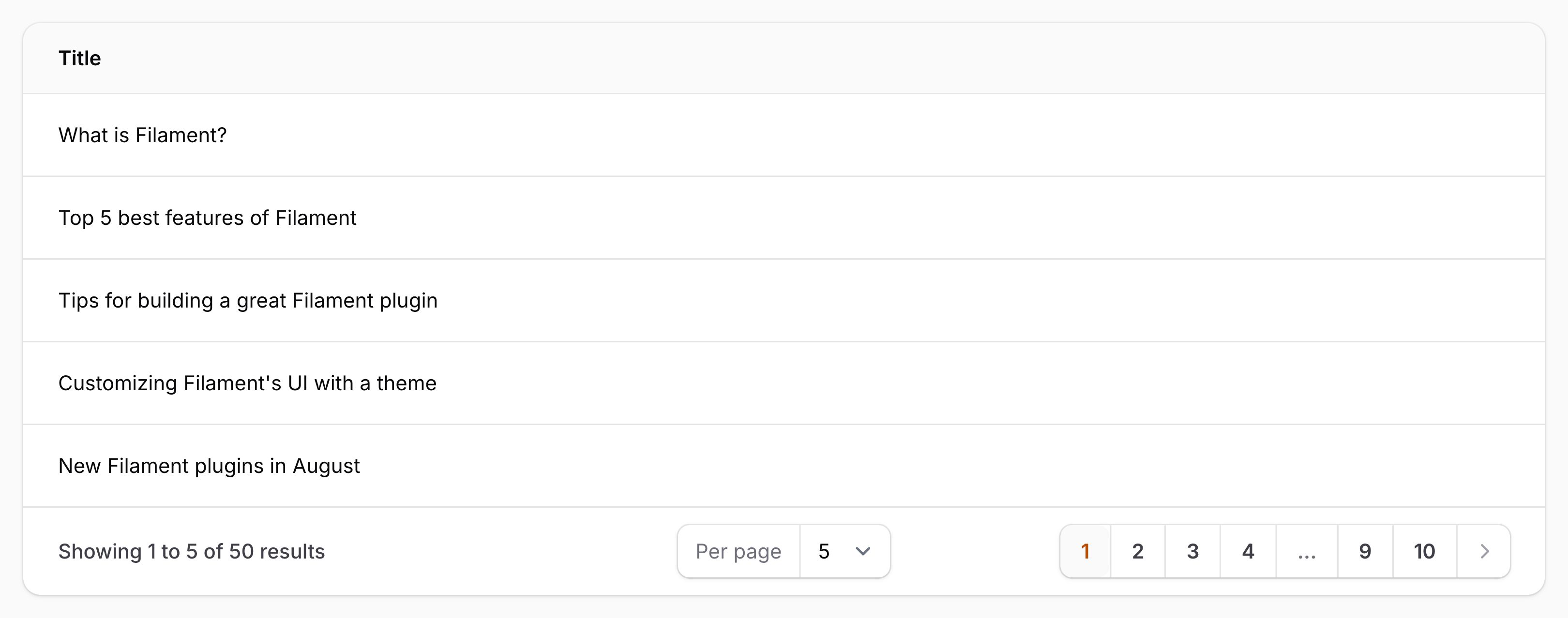
Customizing the color
You may set a color for the text:
use Filament\Tables\Columns\TextColumn;
TextColumn::make('status')
->color('primary')
As well as allowing a static value, the color() method also accepts a function to dynamically calculate it. You can inject various utilities into the function as parameters.
Learn more about utility injection.
| Utility | Type | Parameter | Description |
|---|---|---|---|
| Column | Filament\Tables\Columns\Column | $column | The current column instance. |
| Livewire | Livewire\Component | $livewire | The Livewire component instance. |
| Eloquent record | ?Illuminate\Database\Eloquent\Model | $record | The Eloquent record for the current table row. |
| Row loop | stdClass | $rowLoop | The row loop object for the current table row. |
| State | mixed | $state | The current value of the column, based on the current table row. |
| Table | Filament\Tables\Table | $table | The current table instance. |

Adding an icon
Text columns may also have an icon:
use Filament\Tables\Columns\TextColumn;
use Filament\Support\Icons\Heroicon;
TextColumn::make('email')
->icon(Heroicon::Envelope)
The icon() method also accepts a function to dynamically calculate the icon. You can inject various utilities into the function as parameters.
Learn more about utility injection.
| Utility | Type | Parameter | Description |
|---|---|---|---|
| Column | Filament\Tables\Columns\Column | $column | The current column instance. |
| Livewire | Livewire\Component | $livewire | The Livewire component instance. |
| Eloquent record | ?Illuminate\Database\Eloquent\Model | $record | The Eloquent record for the current table row. |
| Row loop | stdClass | $rowLoop | The row loop object for the current table row. |
| State | mixed | $state | The current value of the column, based on the current table row. |
| Table | Filament\Tables\Table | $table | The current table instance. |
You may set the position of an icon using iconPosition():
use Filament\Tables\Columns\TextColumn;
use Filament\Support\Enums\IconPosition;
use Filament\Support\Icons\Heroicon;
TextColumn::make('email')
->icon(Heroicon::Envelope)
->iconPosition(IconPosition::After) // `IconPosition::Before` or `IconPosition::After`
The iconPosition() method also accepts a function to dynamically calculate the icon position. You can inject various utilities into the function as parameters.
Learn more about utility injection.
| Utility | Type | Parameter | Description |
|---|---|---|---|
| Column | Filament\Tables\Columns\Column | $column | The current column instance. |
| Livewire | Livewire\Component | $livewire | The Livewire component instance. |
| Eloquent record | ?Illuminate\Database\Eloquent\Model | $record | The Eloquent record for the current table row. |
| Row loop | stdClass | $rowLoop | The row loop object for the current table row. |
| State | mixed | $state | The current value of the column, based on the current table row. |
| Table | Filament\Tables\Table | $table | The current table instance. |
The icon color defaults to the text color, but you may customize the icon color separately using iconColor():
use Filament\Tables\Columns\TextColumn;
use Filament\Support\Icons\Heroicon;
TextColumn::make('email')
->icon(Heroicon::Envelope)
->iconColor('primary')
The iconColor() method also accepts a function to dynamically calculate the icon color. You can inject various utilities into the function as parameters.
Learn more about utility injection.
| Utility | Type | Parameter | Description |
|---|---|---|---|
| Column | Filament\Tables\Columns\Column | $column | The current column instance. |
| Livewire | Livewire\Component | $livewire | The Livewire component instance. |
| Eloquent record | ?Illuminate\Database\Eloquent\Model | $record | The Eloquent record for the current table row. |
| Row loop | stdClass | $rowLoop | The row loop object for the current table row. |
| State | mixed | $state | The current value of the column, based on the current table row. |
| Table | Filament\Tables\Table | $table | The current table instance. |
Displaying as a “badge”
By default, text is quite plain and has no background color. You can make it appear as a “badge” instead using the badge() method. A great use case for this is with statuses, where may want to display a badge with a color that matches the status:
use Filament\Tables\Columns\TextColumn;
TextColumn::make('status')
->badge()
->color(fn (string $state): string => match ($state) {
'draft' => 'gray',
'reviewing' => 'warning',
'published' => 'success',
'rejected' => 'danger',
})
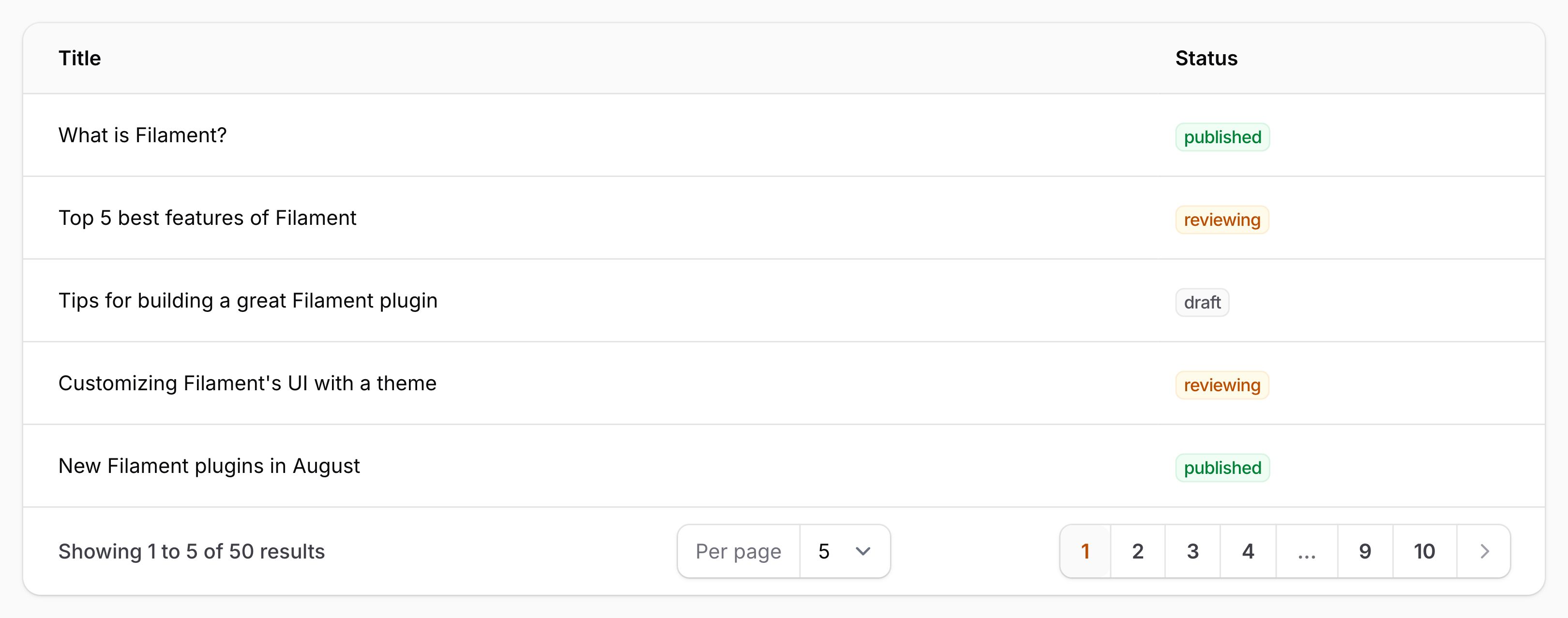
You may add other things to the badge, like an icon.
Optionally, you may pass a boolean value to control if the text should be in a badge or not:
use Filament\Tables\Columns\TextColumn;
TextColumn::make('status')
->badge(FeatureFlag::active())
As well as allowing a static value, the badge() method also accepts a function to dynamically calculate it. You can inject various utilities into the function as parameters.
Learn more about utility injection.
| Utility | Type | Parameter | Description |
|---|---|---|---|
| Column | Filament\Tables\Columns\Column | $column | The current column instance. |
| Livewire | Livewire\Component | $livewire | The Livewire component instance. |
| Eloquent record | ?Illuminate\Database\Eloquent\Model | $record | The Eloquent record for the current table row. |
| Row loop | stdClass | $rowLoop | The row loop object for the current table row. |
| State | mixed | $state | The current value of the column, based on the current table row. |
| Table | Filament\Tables\Table | $table | The current table instance. |
Formatting
When using a text column, you may want the actual outputted text in the UI to differ from the raw state of the column, which is often automatically retrieved from an Eloquent model. Formatting the state allows you to preserve the integrity of the raw data while also allowing it to be presented in a more user-friendly way.
To format the state of a text column without changing the state itself, you can use the formatStateUsing() method. This method accepts a function that takes the state as an argument and returns the formatted state:
use Filament\Tables\Columns\TextColumn;
TextColumn::make('status')
->formatStateUsing(fn (string $state): string => __("statuses.{$state}"))
In this case, the status column in the database might contain values like draft, reviewing, published, or rejected, but the formatted state will be the translated version of these values.
The function passed to formatStateUsing() can inject various utilities as parameters.
Learn more about utility injection.
| Utility | Type | Parameter | Description |
|---|---|---|---|
| Column | Filament\Tables\Columns\Column | $column | The current column instance. |
| Livewire | Livewire\Component | $livewire | The Livewire component instance. |
| Eloquent record | ?Illuminate\Database\Eloquent\Model | $record | The Eloquent record for the current table row. |
| Row loop | stdClass | $rowLoop | The row loop object for the current table row. |
| State | mixed | $state | The current value of the column, based on the current table row. |
| Table | Filament\Tables\Table | $table | The current table instance. |
Date formatting
Instead of passing a function to formatStateUsing(), you may use the date(), dateTime(), and time() methods to format the column’s state using PHP date formatting tokens:
use Filament\Tables\Columns\TextColumn;
TextColumn::make('created_at')
->date()
TextColumn::make('created_at')
->dateTime()
TextColumn::make('created_at')
->time()
You may customize the date format by passing a custom format string to the date(), dateTime(), or time() method. You may use any PHP date formatting tokens:
use Filament\Tables\Columns\TextColumn;
TextColumn::make('created_at')
->date('M j, Y')
TextColumn::make('created_at')
->dateTime('M j, Y H:i:s')
TextColumn::make('created_at')
->time('H:i:s')
As well as allowing static values, the date(), dateTime(), and time() methods also accept a function to dynamically calculate the format. You can inject various utilities into the function as parameters.
Learn more about utility injection.
| Utility | Type | Parameter | Description |
|---|---|---|---|
| Column | Filament\Tables\Columns\Column | $column | The current column instance. |
| Livewire | Livewire\Component | $livewire | The Livewire component instance. |
| Eloquent record | ?Illuminate\Database\Eloquent\Model | $record | The Eloquent record for the current table row. |
| Row loop | stdClass | $rowLoop | The row loop object for the current table row. |
| State | mixed | $state | The current value of the column, based on the current table row. |
| Table | Filament\Tables\Table | $table | The current table instance. |
Date formatting using Carbon macro formats
You may use also the isoDate(), isoDateTime(), and isoTime() methods to format the column’s state using Carbon’s macro-formats:
use Filament\Tables\Columns\TextColumn;
TextColumn::make('created_at')
->isoDate()
TextColumn::make('created_at')
->isoDateTime()
TextColumn::make('created_at')
->isoTime()
You may customize the date format by passing a custom macro format string to the isoDate(), isoDateTime(), or isoTime() method. You may use any Carbon’s macro-formats:
use Filament\Tables\Columns\TextColumn;
TextColumn::make('created_at')
->isoDate('L')
TextColumn::make('created_at')
->isoDateTime('LLL')
TextColumn::make('created_at')
->isoTime('LT')
As well as allowing static values, the isoDate(), isoDateTime(), and isoTime() methods also accept a function to dynamically calculate the format. You can inject various utilities into the function as parameters.
Learn more about utility injection.
| Utility | Type | Parameter | Description |
|---|---|---|---|
| Column | Filament\Tables\Columns\Column | $column | The current column instance. |
| Livewire | Livewire\Component | $livewire | The Livewire component instance. |
| Eloquent record | ?Illuminate\Database\Eloquent\Model | $record | The Eloquent record for the current table row. |
| Row loop | stdClass | $rowLoop | The row loop object for the current table row. |
| State | mixed | $state | The current value of the column, based on the current table row. |
| Table | Filament\Tables\Table | $table | The current table instance. |
Relative date formatting
You may use the since() method to format the column’s state using Carbon’s diffForHumans():
use Filament\Tables\Columns\TextColumn;
TextColumn::make('created_at')
->since()
Displaying a formatting date in a tooltip
Additionally, you can use the dateTooltip(), dateTimeTooltip(), timeTooltip(), isoDateTooltip(), isoDateTimeTooltip(), isoTime(), isoTimeTooltip(), or sinceTooltip() method to display a formatted date in a tooltip, often to provide extra information:
use Filament\Tables\Columns\TextColumn;
TextColumn::make('created_at')
->since()
->dateTooltip() // Accepts a custom PHP date formatting string
TextColumn::make('created_at')
->since()
->dateTimeTooltip() // Accepts a custom PHP date formatting string
TextColumn::make('created_at')
->since()
->timeTooltip() // Accepts a custom PHP date formatting string
TextColumn::make('created_at')
->since()
->isoDateTooltip() // Accepts a custom Carbon macro format string
TextColumn::make('created_at')
->since()
->isoDateTimeTooltip() // Accepts a custom Carbon macro format string
TextColumn::make('created_at')
->since()
->isoTimeTooltip() // Accepts a custom Carbon macro format string
TextColumn::make('created_at')
->dateTime()
->sinceTooltip()
Setting the timezone for date formatting
Each of the date formatting methods listed above also accepts a timezone argument, which allows you to convert the time set in the state to a different timezone:
use Filament\Tables\Columns\TextColumn;
TextColumn::make('created_at')
->dateTime(timezone: 'America/New_York')
You can also pass a timezone to the timezone() method of the column to apply a timezone to all date-time formatting methods at once:
use Filament\Tables\Columns\TextColumn;
TextColumn::make('created_at')
->timezone('America/New_York')
->dateTime()
As well as allowing static values, the timezone() method also accepts a function to dynamically calculate the timezone. You can inject various utilities into the function as parameters.
Learn more about utility injection.
| Utility | Type | Parameter | Description |
|---|---|---|---|
| Column | Filament\Tables\Columns\Column | $column | The current column instance. |
| Livewire | Livewire\Component | $livewire | The Livewire component instance. |
| Eloquent record | ?Illuminate\Database\Eloquent\Model | $record | The Eloquent record for the current table row. |
| Row loop | stdClass | $rowLoop | The row loop object for the current table row. |
| State | mixed | $state | The current value of the column, based on the current table row. |
| Table | Filament\Tables\Table | $table | The current table instance. |
If you do not pass a timezone() to the column, it will use Filament’s default timezone. You can set Filament’s default timezone using the FilamentTimezone::set() method in the boot() method of a service provider such as AppServiceProvider:
use Filament\Support\Facades\FilamentTimezone;
public function boot(): void
{
FilamentTimezone::set('America/New_York');
}
This is useful if you want to set a default timezone for all text columns in your application. It is also used in other places where timezones are used in Filament.
NOTE
Filament’s default timezone will only apply when the column stores a time. If the column stores a date only (date() instead of dateTime()), the timezone will not be applied. This is to prevent timezone shifts when storing dates without times.
Number formatting
Instead of passing a function to formatStateUsing(), you can use the numeric() method to format a column as a number:
use Filament\Tables\Columns\TextColumn;
TextColumn::make('stock')
->numeric()
If you would like to customize the number of decimal places used to format the number with, you can use the decimalPlaces argument:
use Filament\Tables\Columns\TextColumn;
TextColumn::make('stock')
->numeric(decimalPlaces: 0)
As well as allowing static values, the decimalPlaces argument also accepts a function to dynamically calculate it. You can inject various utilities into the function as parameters.
Learn more about utility injection.
| Utility | Type | Parameter | Description |
|---|---|---|---|
| Column | Filament\Tables\Columns\Column | $column | The current column instance. |
| Livewire | Livewire\Component | $livewire | The Livewire component instance. |
| Eloquent record | ?Illuminate\Database\Eloquent\Model | $record | The Eloquent record for the current table row. |
| Row loop | stdClass | $rowLoop | The row loop object for the current table row. |
| State | mixed | $state | The current value of the column, based on the current table row. |
| Table | Filament\Tables\Table | $table | The current table instance. |
By default, your app’s locale will be used to format the number suitably. If you would like to customize the locale used, you can pass it to the locale argument:
use Filament\Tables\Columns\TextColumn;
TextColumn::make('stock')
->numeric(locale: 'nl')
As well as allowing static values, the locale argument also accepts a function to dynamically calculate it. You can inject various utilities into the function as parameters.
Learn more about utility injection.
| Utility | Type | Parameter | Description |
|---|---|---|---|
| Column | Filament\Tables\Columns\Column | $column | The current column instance. |
| Livewire | Livewire\Component | $livewire | The Livewire component instance. |
| Eloquent record | ?Illuminate\Database\Eloquent\Model | $record | The Eloquent record for the current table row. |
| Row loop | stdClass | $rowLoop | The row loop object for the current table row. |
| State | mixed | $state | The current value of the column, based on the current table row. |
| Table | Filament\Tables\Table | $table | The current table instance. |
Money formatting
Instead of passing a function to formatStateUsing(), you can use the money() method to easily format amounts of money, in any currency:
use Filament\Tables\Columns\TextColumn;
TextColumn::make('price')
->money('EUR')
As well as allowing static values, the money() method also accepts a function to dynamically calculate it. You can inject various utilities into the function as parameters.
Learn more about utility injection.
| Utility | Type | Parameter | Description |
|---|---|---|---|
| Column | Filament\Tables\Columns\Column | $column | The current column instance. |
| Livewire | Livewire\Component | $livewire | The Livewire component instance. |
| Eloquent record | ?Illuminate\Database\Eloquent\Model | $record | The Eloquent record for the current table row. |
| Row loop | stdClass | $rowLoop | The row loop object for the current table row. |
| State | mixed | $state | The current value of the column, based on the current table row. |
| Table | Filament\Tables\Table | $table | The current table instance. |
There is also a divideBy argument for money() that allows you to divide the original value by a number before formatting it. This could be useful if your database stores the price in cents, for example:
use Filament\Tables\Columns\TextColumn;
TextColumn::make('price')
->money('EUR', divideBy: 100)
As well as allowing static values, the divideBy argument also accepts a function to dynamically calculate it. You can inject various utilities into the function as parameters.
Learn more about utility injection.
| Utility | Type | Parameter | Description |
|---|---|---|---|
| Column | Filament\Tables\Columns\Column | $column | The current column instance. |
| Livewire | Livewire\Component | $livewire | The Livewire component instance. |
| Eloquent record | ?Illuminate\Database\Eloquent\Model | $record | The Eloquent record for the current table row. |
| Row loop | stdClass | $rowLoop | The row loop object for the current table row. |
| State | mixed | $state | The current value of the column, based on the current table row. |
| Table | Filament\Tables\Table | $table | The current table instance. |
By default, your app’s locale will be used to format the money suitably. If you would like to customize the locale used, you can pass it to the locale argument:
use Filament\Tables\Columns\TextColumn;
TextColumn::make('price')
->money('EUR', locale: 'nl')
As well as allowing static values, the locale argument also accepts a function to dynamically calculate it. You can inject various utilities into the function as parameters.
Learn more about utility injection.
| Utility | Type | Parameter | Description |
|---|---|---|---|
| Column | Filament\Tables\Columns\Column | $column | The current column instance. |
| Livewire | Livewire\Component | $livewire | The Livewire component instance. |
| Eloquent record | ?Illuminate\Database\Eloquent\Model | $record | The Eloquent record for the current table row. |
| Row loop | stdClass | $rowLoop | The row loop object for the current table row. |
| State | mixed | $state | The current value of the column, based on the current table row. |
| Table | Filament\Tables\Table | $table | The current table instance. |
If you would like to customize the number of decimal places used to format the number with, you can use the decimalPlaces argument:
use Filament\Tables\Columns\TextColumn;
TextColumn::make('price')
->money('EUR', decimalPlaces: 3)
As well as allowing static values, the decimalPlaces argument also accepts a function to dynamically calculate it. You can inject various utilities into the function as parameters.
Learn more about utility injection.
| Utility | Type | Parameter | Description |
|---|---|---|---|
| Column | Filament\Tables\Columns\Column | $column | The current column instance. |
| Livewire | Livewire\Component | $livewire | The Livewire component instance. |
| Eloquent record | ?Illuminate\Database\Eloquent\Model | $record | The Eloquent record for the current table row. |
| Row loop | stdClass | $rowLoop | The row loop object for the current table row. |
| State | mixed | $state | The current value of the column, based on the current table row. |
| Table | Filament\Tables\Table | $table | The current table instance. |
Rendering Markdown
If your column value is Markdown, you may render it using markdown():
use Filament\Tables\Columns\TextColumn;
TextColumn::make('description')
->markdown()
Optionally, you may pass a boolean value to control if the text should be rendered as Markdown or not:
use Filament\Tables\Columns\TextColumn;
TextColumn::make('description')
->markdown(FeatureFlag::active())
As well as allowing a static value, the markdown() method also accepts a function to dynamically calculate it. You can inject various utilities into the function as parameters.
Learn more about utility injection.
| Utility | Type | Parameter | Description |
|---|---|---|---|
| Column | Filament\Tables\Columns\Column | $column | The current column instance. |
| Livewire | Livewire\Component | $livewire | The Livewire component instance. |
| Eloquent record | ?Illuminate\Database\Eloquent\Model | $record | The Eloquent record for the current table row. |
| Row loop | stdClass | $rowLoop | The row loop object for the current table row. |
| State | mixed | $state | The current value of the column, based on the current table row. |
| Table | Filament\Tables\Table | $table | The current table instance. |
Rendering HTML
If your column value is HTML, you may render it using html():
use Filament\Tables\Columns\TextColumn;
TextColumn::make('description')
->html()
Optionally, you may pass a boolean value to control if the text should be rendered as HTML or not:
use Filament\Tables\Columns\TextColumn;
TextColumn::make('description')
->html(FeatureFlag::active())
As well as allowing a static value, the html() method also accepts a function to dynamically calculate it. You can inject various utilities into the function as parameters.
Learn more about utility injection.
| Utility | Type | Parameter | Description |
|---|---|---|---|
| Column | Filament\Tables\Columns\Column | $column | The current column instance. |
| Livewire | Livewire\Component | $livewire | The Livewire component instance. |
| Eloquent record | ?Illuminate\Database\Eloquent\Model | $record | The Eloquent record for the current table row. |
| Row loop | stdClass | $rowLoop | The row loop object for the current table row. |
| State | mixed | $state | The current value of the column, based on the current table row. |
| Table | Filament\Tables\Table | $table | The current table instance. |
Rendering raw HTML without sanitization
If you use this method, then the HTML will be sanitized to remove any potentially unsafe content before it is rendered. If you’d like to opt out of this behavior, you can wrap the HTML in an HtmlString object by formatting it:
use Filament\Tables\Columns\TextColumn;
use Illuminate\Support\HtmlString;
TextColumn::make('description')
->formatStateUsing(fn (string $state): HtmlString => new HtmlString($state))
NOTE
Be cautious when rendering raw HTML, as it may contain malicious content, which can lead to security vulnerabilities in your app such as cross-site scripting (XSS) attacks. Always ensure that the HTML you are rendering is safe before using this method.
Alternatively, you can return a view() object from the formatStateUsing() method, which will also not be sanitized:
use Filament\Tables\Columns\TextColumn;
use Illuminate\Contracts\View\View;
TextColumn::make('description')
->formatStateUsing(fn (string $state): View => view(
'filament.tables.columns.description-column-content',
['state' => $state],
))
Displaying a description
Descriptions may be used to easily render additional text above or below the column contents.
You can display a description below the contents of a text column using the description() method:
use Filament\Tables\Columns\TextColumn;
TextColumn::make('title')
->description(fn (Post $record): string => $record->description)
The function passed to description() can inject various utilities as parameters.
Learn more about utility injection.
| Utility | Type | Parameter | Description |
|---|---|---|---|
| Column | Filament\Tables\Columns\Column | $column | The current column instance. |
| Livewire | Livewire\Component | $livewire | The Livewire component instance. |
| Eloquent record | ?Illuminate\Database\Eloquent\Model | $record | The Eloquent record for the current table row. |
| Row loop | stdClass | $rowLoop | The row loop object for the current table row. |
| State | mixed | $state | The current value of the column, based on the current table row. |
| Table | Filament\Tables\Table | $table | The current table instance. |
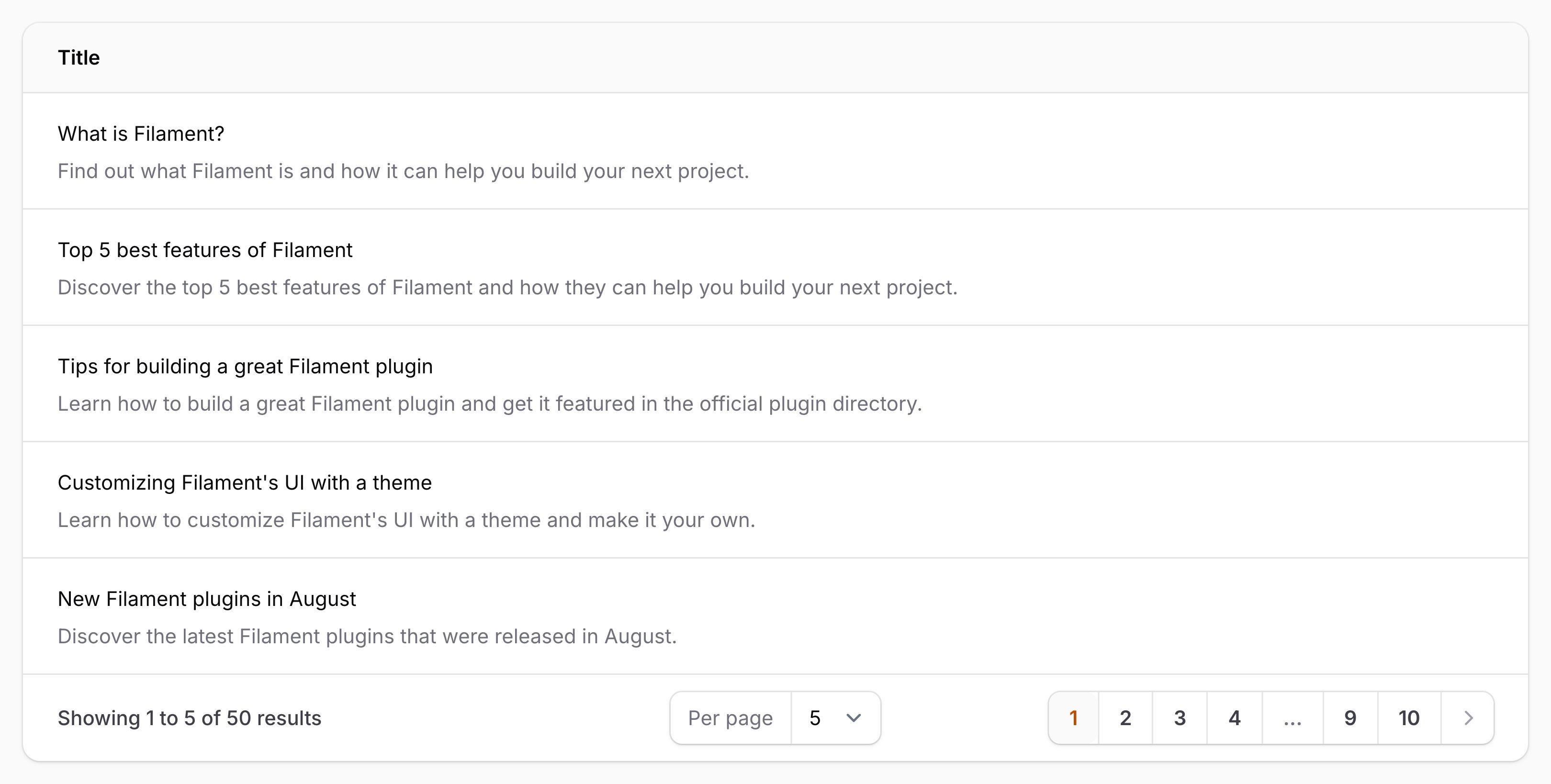
By default, the description is displayed below the main text, but you can move it using 'above' as the second parameter:
use Filament\Tables\Columns\TextColumn;
TextColumn::make('title')
->description(fn (Post $record): string => $record->description, position: 'above')
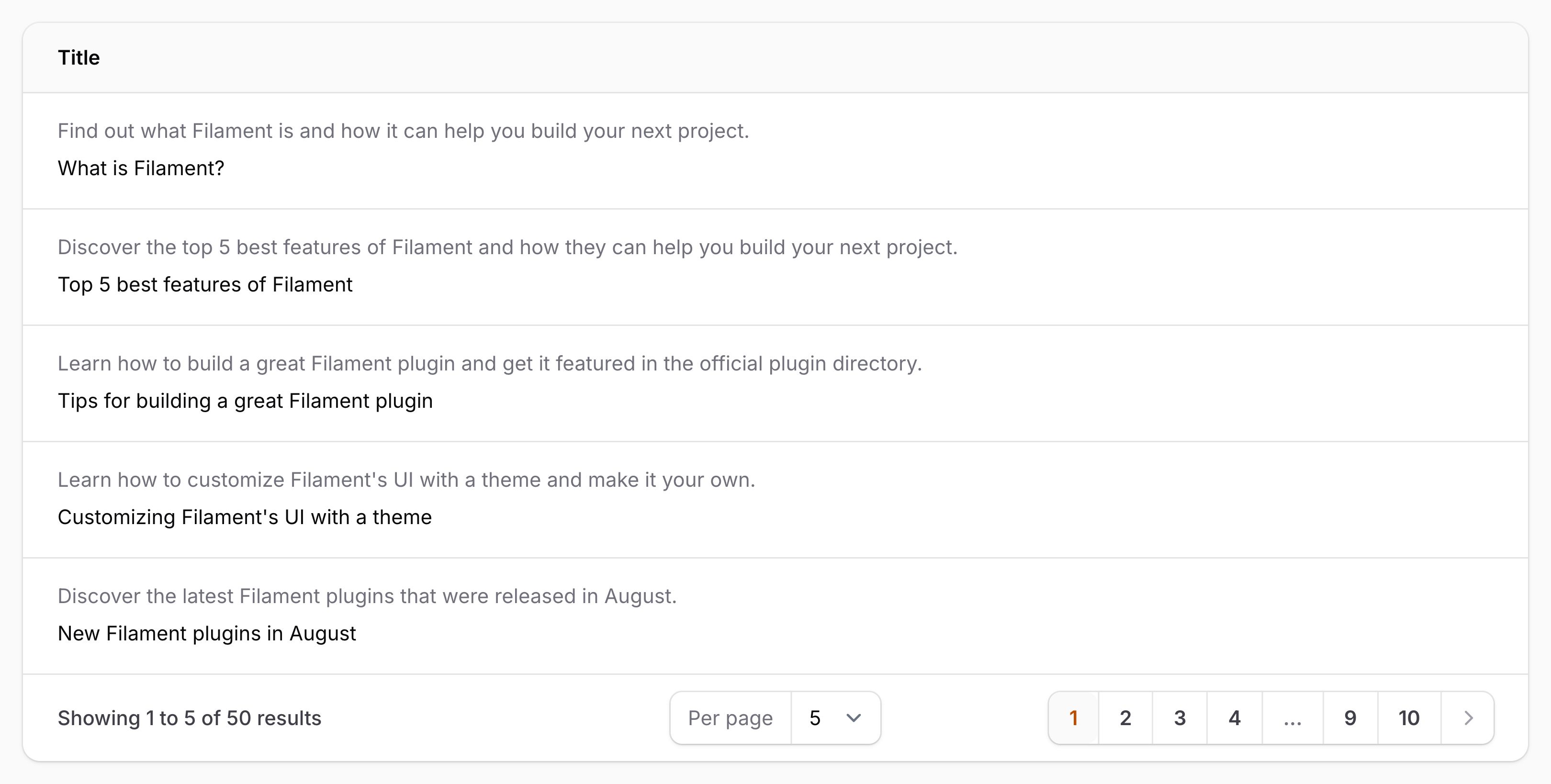
Listing multiple values
Multiple values can be rendered in a text column if its state is an array. This can happen if you are using an array cast on an Eloquent attribute, an Eloquent relationship with multiple results, or if you have passed an array to the state() method. If there are multiple values inside your text column, they will be comma-separated. You may use the listWithLineBreaks() method to display them on new lines instead:
use Filament\Tables\Columns\TextColumn;
TextColumn::make('authors.name')
->listWithLineBreaks()
Optionally, you may pass a boolean value to control if the text should have line breaks between each item or not:
use Filament\Tables\Columns\TextColumn;
TextColumn::make('authors.name')
->listWithLineBreaks(FeatureFlag::active())
As well as allowing a static value, the listWithLineBreaks() method also accepts a function to dynamically calculate it. You can inject various utilities into the function as parameters.
Learn more about utility injection.
| Utility | Type | Parameter | Description |
|---|---|---|---|
| Column | Filament\Tables\Columns\Column | $column | The current column instance. |
| Livewire | Livewire\Component | $livewire | The Livewire component instance. |
| Eloquent record | ?Illuminate\Database\Eloquent\Model | $record | The Eloquent record for the current table row. |
| Row loop | stdClass | $rowLoop | The row loop object for the current table row. |
| State | mixed | $state | The current value of the column, based on the current table row. |
| Table | Filament\Tables\Table | $table | The current table instance. |
Adding bullet points to the list
You may add a bullet point to each list item using the bulleted() method:
use Filament\Tables\Columns\TextColumn;
TextColumn::make('authors.name')
->bulleted()
Optionally, you may pass a boolean value to control if the text should have bullet points or not:
use Filament\Tables\Columns\TextColumn;
TextColumn::make('authors.name')
->bulleted(FeatureFlag::active())
As well as allowing a static value, the bulleted() method also accepts a function to dynamically calculate it. You can inject various utilities into the function as parameters.
Learn more about utility injection.
| Utility | Type | Parameter | Description |
|---|---|---|---|
| Column | Filament\Tables\Columns\Column | $column | The current column instance. |
| Livewire | Livewire\Component | $livewire | The Livewire component instance. |
| Eloquent record | ?Illuminate\Database\Eloquent\Model | $record | The Eloquent record for the current table row. |
| Row loop | stdClass | $rowLoop | The row loop object for the current table row. |
| State | mixed | $state | The current value of the column, based on the current table row. |
| Table | Filament\Tables\Table | $table | The current table instance. |
Limiting the number of values in the list
You can limit the number of values in the list using the limitList() method:
use Filament\Tables\Columns\TextColumn;
TextColumn::make('authors.name')
->listWithLineBreaks()
->limitList(3)
As well as allowing a static value, the limitList() method also accepts a function to dynamically calculate it. You can inject various utilities into the function as parameters.
Learn more about utility injection.
| Utility | Type | Parameter | Description |
|---|---|---|---|
| Column | Filament\Tables\Columns\Column | $column | The current column instance. |
| Livewire | Livewire\Component | $livewire | The Livewire component instance. |
| Eloquent record | ?Illuminate\Database\Eloquent\Model | $record | The Eloquent record for the current table row. |
| Row loop | stdClass | $rowLoop | The row loop object for the current table row. |
| State | mixed | $state | The current value of the column, based on the current table row. |
| Table | Filament\Tables\Table | $table | The current table instance. |
Expanding the limited list
You can allow the limited items to be expanded and collapsed, using the expandableLimitedList() method:
use Filament\Tables\Columns\TextColumn;
TextColumn::make('authors.name')
->listWithLineBreaks()
->limitList(3)
->expandableLimitedList()
NOTE
This is only a feature for listWithLineBreaks() or bulleted(), where each item is on its own line.
Optionally, you may pass a boolean value to control if the text should be expandable or not:
use Filament\Tables\Columns\TextColumn;
TextColumn::make('authors.name')
->listWithLineBreaks()
->limitList(3)
->expandableLimitedList(FeatureFlag::active())
As well as allowing a static value, the expandableLimitedList() method also accepts a function to dynamically calculate it. You can inject various utilities into the function as parameters.
Learn more about utility injection.
| Utility | Type | Parameter | Description |
|---|---|---|---|
| Column | Filament\Tables\Columns\Column | $column | The current column instance. |
| Livewire | Livewire\Component | $livewire | The Livewire component instance. |
| Eloquent record | ?Illuminate\Database\Eloquent\Model | $record | The Eloquent record for the current table row. |
| Row loop | stdClass | $rowLoop | The row loop object for the current table row. |
| State | mixed | $state | The current value of the column, based on the current table row. |
| Table | Filament\Tables\Table | $table | The current table instance. |
Splitting a single value into multiple list items
If you want to “explode” a text string from your model into multiple list items, you can do so with the separator() method. This is useful for displaying comma-separated tags as badges, for example:
use Filament\Tables\Columns\TextColumn;
TextColumn::make('tags')
->badge()
->separator(',')
As well as allowing a static value, the separator() method also accepts a function to dynamically calculate it. You can inject various utilities into the function as parameters.
Learn more about utility injection.
| Utility | Type | Parameter | Description |
|---|---|---|---|
| Column | Filament\Tables\Columns\Column | $column | The current column instance. |
| Livewire | Livewire\Component | $livewire | The Livewire component instance. |
| Eloquent record | ?Illuminate\Database\Eloquent\Model | $record | The Eloquent record for the current table row. |
| Row loop | stdClass | $rowLoop | The row loop object for the current table row. |
| State | mixed | $state | The current value of the column, based on the current table row. |
| Table | Filament\Tables\Table | $table | The current table instance. |
Customizing the text size
Text columns have small font size by default, but you may change this to TextSize::ExtraSmall, TextSize::Medium, or TextSize::Large.
For instance, you may make the text larger using size(TextSize::Large):
use Filament\Tables\Columns\TextColumn;
use Filament\Support\Enums\TextSize;
TextColumn::make('title')
->size(TextSize::Large)

Customizing the font weight
Text columns have regular font weight by default, but you may change this to any of the following options: FontWeight::Thin, FontWeight::ExtraLight, FontWeight::Light, FontWeight::Medium, FontWeight::SemiBold, FontWeight::Bold, FontWeight::ExtraBold or FontWeight::Black.
For instance, you may make the font bold using weight(FontWeight::Bold):
use Filament\Tables\Columns\TextColumn;
use Filament\Support\Enums\FontWeight;
TextColumn::make('title')
->weight(FontWeight::Bold)
As well as allowing a static value, the weight() method also accepts a function to dynamically calculate it. You can inject various utilities into the function as parameters.
Learn more about utility injection.
| Utility | Type | Parameter | Description |
|---|---|---|---|
| Column | Filament\Tables\Columns\Column | $column | The current column instance. |
| Livewire | Livewire\Component | $livewire | The Livewire component instance. |
| Eloquent record | ?Illuminate\Database\Eloquent\Model | $record | The Eloquent record for the current table row. |
| Row loop | stdClass | $rowLoop | The row loop object for the current table row. |
| State | mixed | $state | The current value of the column, based on the current table row. |
| Table | Filament\Tables\Table | $table | The current table instance. |
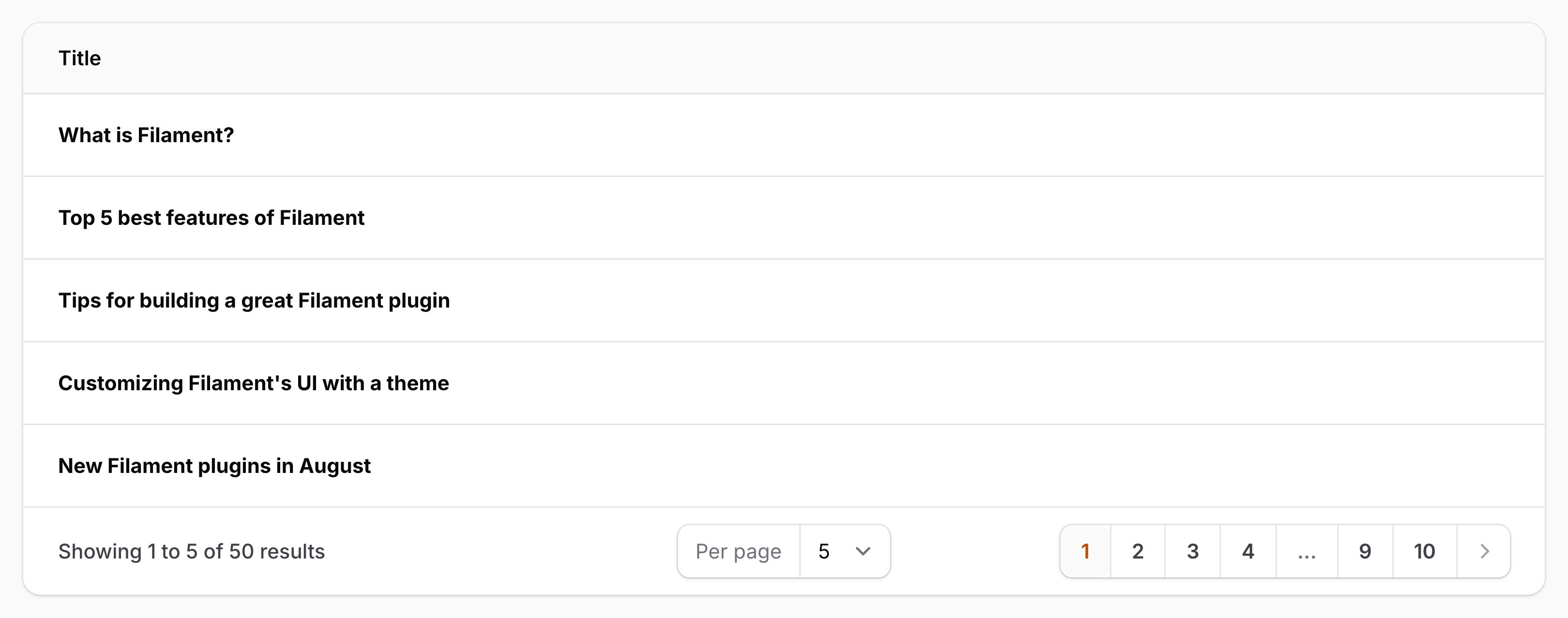
Customizing the font family
You can change the text font family to any of the following options: FontFamily::Sans, FontFamily::Serif or FontFamily::Mono.
For instance, you may make the font monospaced using fontFamily(FontFamily::Mono):
use Filament\Support\Enums\FontFamily;
use Filament\Tables\Columns\TextColumn;
TextColumn::make('email')
->fontFamily(FontFamily::Mono)
As well as allowing a static value, the fontFamily() method also accepts a function to dynamically calculate it. You can inject various utilities into the function as parameters.
Learn more about utility injection.
| Utility | Type | Parameter | Description |
|---|---|---|---|
| Column | Filament\Tables\Columns\Column | $column | The current column instance. |
| Livewire | Livewire\Component | $livewire | The Livewire component instance. |
| Eloquent record | ?Illuminate\Database\Eloquent\Model | $record | The Eloquent record for the current table row. |
| Row loop | stdClass | $rowLoop | The row loop object for the current table row. |
| State | mixed | $state | The current value of the column, based on the current table row. |
| Table | Filament\Tables\Table | $table | The current table instance. |
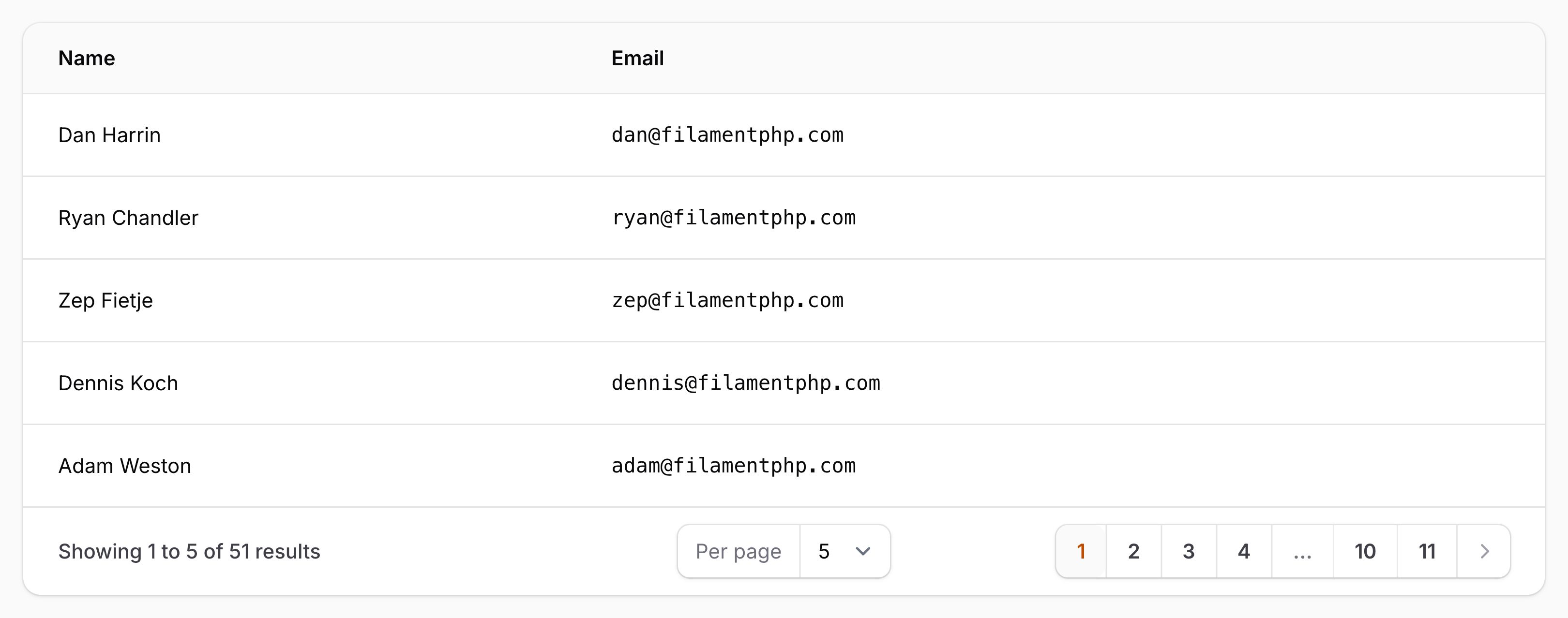
Handling long text
Limiting text length
You may limit() the length of the column’s value:
use Filament\Tables\Columns\TextColumn;
TextColumn::make('description')
->limit(50)
As well as allowing a static value, the limit() method also accepts a function to dynamically calculate it. You can inject various utilities into the function as parameters.
Learn more about utility injection.
| Utility | Type | Parameter | Description |
|---|---|---|---|
| Column | Filament\Tables\Columns\Column | $column | The current column instance. |
| Livewire | Livewire\Component | $livewire | The Livewire component instance. |
| Eloquent record | ?Illuminate\Database\Eloquent\Model | $record | The Eloquent record for the current table row. |
| Row loop | stdClass | $rowLoop | The row loop object for the current table row. |
| State | mixed | $state | The current value of the column, based on the current table row. |
| Table | Filament\Tables\Table | $table | The current table instance. |
By default, when text is truncated, an ellipsis (...) is appended to the end of the text. You may customize this by passing a custom string to the end argument:
use Filament\Tables\Columns\TextColumn;
TextColumn::make('description')
->limit(50, end: ' (more)')
As well as allowing a static value, the end argument also accepts a function to dynamically calculate it. You can inject various utilities into the function as parameters.
Learn more about utility injection.
| Utility | Type | Parameter | Description |
|---|---|---|---|
| Column | Filament\Tables\Columns\Column | $column | The current column instance. |
| Livewire | Livewire\Component | $livewire | The Livewire component instance. |
| Eloquent record | ?Illuminate\Database\Eloquent\Model | $record | The Eloquent record for the current table row. |
| Row loop | stdClass | $rowLoop | The row loop object for the current table row. |
| State | mixed | $state | The current value of the column, based on the current table row. |
| Table | Filament\Tables\Table | $table | The current table instance. |
You may also reuse the value that is being passed to limit() in a function, by getting it using the getCharacterLimit() method:
use Filament\Tables\Columns\TextColumn;
TextColumn::make('description')
->limit(50)
->tooltip(function (TextColumn $column): ?string {
$state = $column->getState();
if (strlen($state) <= $column->getCharacterLimit()) {
return null;
}
// Only render the tooltip if the column contents exceeds the length limit.
return $state;
})
Limiting word count
You may limit the number of words() displayed in the column:
use Filament\Tables\Columns\TextColumn;
TextColumn::make('description')
->words(10)
As well as allowing a static value, the words() method also accepts a function to dynamically calculate it. You can inject various utilities into the function as parameters.
Learn more about utility injection.
| Utility | Type | Parameter | Description |
|---|---|---|---|
| Column | Filament\Tables\Columns\Column | $column | The current column instance. |
| Livewire | Livewire\Component | $livewire | The Livewire component instance. |
| Eloquent record | ?Illuminate\Database\Eloquent\Model | $record | The Eloquent record for the current table row. |
| Row loop | stdClass | $rowLoop | The row loop object for the current table row. |
| State | mixed | $state | The current value of the column, based on the current table row. |
| Table | Filament\Tables\Table | $table | The current table instance. |
By default, when text is truncated, an ellipsis (...) is appended to the end of the text. You may customize this by passing a custom string to the end argument:
use Filament\Tables\Columns\TextColumn;
TextColumn::make('description')
->words(10, end: ' (more)')
As well as allowing a static value, the end argument also accepts a function to dynamically calculate it. You can inject various utilities into the function as parameters.
Learn more about utility injection.
| Utility | Type | Parameter | Description |
|---|---|---|---|
| Column | Filament\Tables\Columns\Column | $column | The current column instance. |
| Livewire | Livewire\Component | $livewire | The Livewire component instance. |
| Eloquent record | ?Illuminate\Database\Eloquent\Model | $record | The Eloquent record for the current table row. |
| Row loop | stdClass | $rowLoop | The row loop object for the current table row. |
| State | mixed | $state | The current value of the column, based on the current table row. |
| Table | Filament\Tables\Table | $table | The current table instance. |
Allowing text wrapping
By default, text will not wrap to the next line if it exceeds the width of the container. You can enable this behavior using the wrap() method:
use Filament\Tables\Columns\TextColumn;
TextColumn::make('description')
->wrap()
Optionally, you may pass a boolean value to control if the text should wrap or not:
use Filament\Tables\Columns\TextColumn;
TextColumn::make('description')
->wrap(FeatureFlag::active())
As well as allowing a static value, the wrap() method also accepts a function to dynamically calculate it. You can inject various utilities into the function as parameters.
Learn more about utility injection.
| Utility | Type | Parameter | Description |
|---|---|---|---|
| Column | Filament\Tables\Columns\Column | $column | The current column instance. |
| Livewire | Livewire\Component | $livewire | The Livewire component instance. |
| Eloquent record | ?Illuminate\Database\Eloquent\Model | $record | The Eloquent record for the current table row. |
| Row loop | stdClass | $rowLoop | The row loop object for the current table row. |
| State | mixed | $state | The current value of the column, based on the current table row. |
| Table | Filament\Tables\Table | $table | The current table instance. |
Limiting text to a specific number of lines
You may want to limit text to a specific number of lines instead of limiting it to a fixed length. Clamping text to a number of lines is useful in responsive interfaces where you want to ensure a consistent experience across all screen sizes. This can be achieved using the lineClamp() method:
use Filament\Tables\Columns\TextColumn;
TextColumn::make('description')
->wrap()
->lineClamp(2)
As well as allowing a static value, the lineClamp() method also accepts a function to dynamically calculate it. You can inject various utilities into the function as parameters.
Learn more about utility injection.
| Utility | Type | Parameter | Description |
|---|---|---|---|
| Column | Filament\Tables\Columns\Column | $column | The current column instance. |
| Livewire | Livewire\Component | $livewire | The Livewire component instance. |
| Eloquent record | ?Illuminate\Database\Eloquent\Model | $record | The Eloquent record for the current table row. |
| Row loop | stdClass | $rowLoop | The row loop object for the current table row. |
| State | mixed | $state | The current value of the column, based on the current table row. |
| Table | Filament\Tables\Table | $table | The current table instance. |
Allowing the text to be copied to the clipboard
You may make the text copyable, such that clicking on the column copies the text to the clipboard, and optionally specify a custom confirmation message and duration in milliseconds:
use Filament\Tables\Columns\TextColumn;
TextColumn::make('email')
->copyable()
->copyMessage('Email address copied')
->copyMessageDuration(1500)
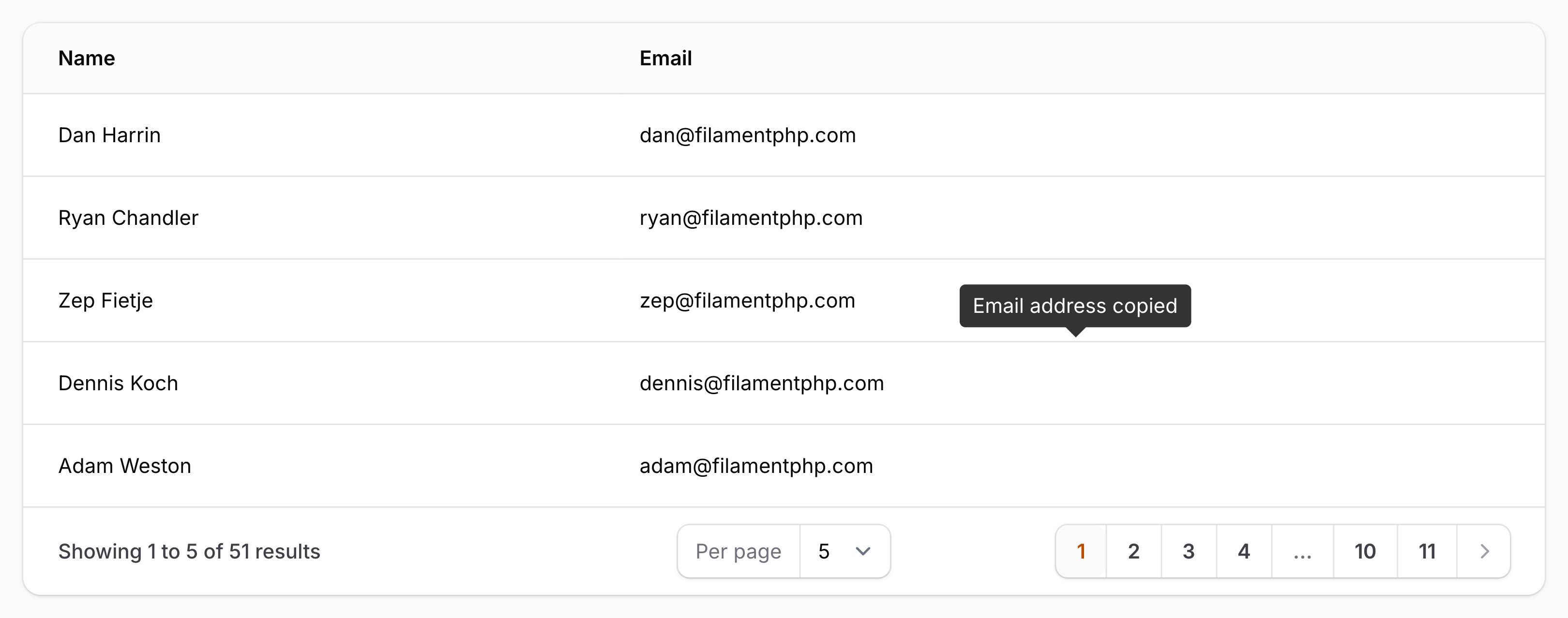
Optionally, you may pass a boolean value to control if the text should be copyable or not:
use Filament\Tables\Columns\TextColumn;
TextColumn::make('email')
->copyable(FeatureFlag::active())
As well as allowing static values, the copyable(), copyMessage(), and copyMessageDuration() methods also accept functions to dynamically calculate them. You can inject various utilities into the function as parameters.
Learn more about utility injection.
| Utility | Type | Parameter | Description |
|---|---|---|---|
| Column | Filament\Tables\Columns\Column | $column | The current column instance. |
| Livewire | Livewire\Component | $livewire | The Livewire component instance. |
| Eloquent record | ?Illuminate\Database\Eloquent\Model | $record | The Eloquent record for the current table row. |
| Row loop | stdClass | $rowLoop | The row loop object for the current table row. |
| State | mixed | $state | The current value of the column, based on the current table row. |
| Table | Filament\Tables\Table | $table | The current table instance. |
NOTE
This feature only works when SSL is enabled for the app.
Still need help? Join our Discord community or open a GitHub discussion









